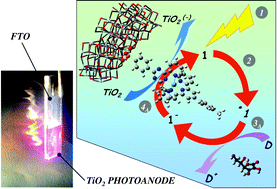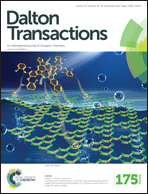Charge injection into nanostructured TiO2 electrodes from the photogenerated reduced form of a new Ru(ii) polypyridine compound: the “anti-biomimetic” mechanism at work†
Abstract
The charge transfer dynamics involving a new Ru(II) polypyridine complex (1), developed to generate highly oxidizing photoholes for water oxidation, was studied by electrochemical, photoelectrochemical and spectroscopic means. Mesoporous TiO2 electrodes sensitized with complex 1, under 1 sun illumination (420 nm cut-off filter) and a moderate applied bias (0.3 V vs. SCE), in ACN/0.1 M LiI as a sacrificial electron donor reach an anodic photocurrent of ∼0.2 mA cm−2 with 3% photon-to-current conversion efficiency. When 0.1 M aqueous sodium ascorbate (pH 3) is used instead of iodide, the photocurrent increases to ∼0.7 mA cm−2 and up to 1 mA cm−2 if the concentration of ascorbate is increased to 0.5 M, explainable with a modification of the charge injection mechanism. This is the photoelectrochemical evidence, in the heterogeneous phase, of the so-called “anti-biomimetic” pathway, confirmed in transient absorption spectroscopy by a long lived sharp bleaching at 480 nm and a narrow absorption between 500 and 550 nm, characteristic fingerprints of the photogenerated reduced state (1−). After the formation of *1/TiO2, reductive quenching by ascorbate occurs, not observed in LiI where the classic oxidative quenching takes place. Due to the modest excited state oxidation potential, electron transfer to TiO2 is thermodynamically more favorable from 1− than *1. Lastly, experiments performed with sensitized SnO2 photoanodes, where *1 undergoes the usual oxidative quenching, by charge transfer to the conduction band of the metal oxide allowed us to verify the interaction between 1+ and IrO2 nanoparticles, grafted onto the surface in order to drive photoinduced water oxidation.


 Please wait while we load your content...
Please wait while we load your content...